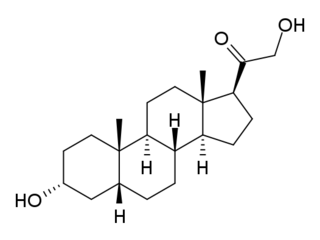
γ-Aminobutyric acid, or GABA, is the chief inhibitory neurotransmitter in the developmentally mature mammalian central nervous system. Its principal role is reducing neuronal excitability throughout the nervous system.

The GABA receptors are a class of receptors that respond to the neurotransmitter gamma-aminobutyric acid (GABA), the chief inhibitory compound in the mature vertebrate central nervous system. There are two classes of GABA receptors: GABAA and GABAB. GABAA receptors are ligand-gated ion channels ; whereas GABAB receptors are G protein-coupled receptors, also called metabotropic receptors.

Flumazenil is a selective GABAA receptor antagonist administered via injection, otic insertion, or intranasally. Therapeutically, it acts as both an antagonist and antidote to benzodiazepines, through competitive inhibition.

The GABAA receptor (GABAAR) is an ionotropic receptor and ligand-gated ion channel. Its endogenous ligand is γ-aminobutyric acid (GABA), the major inhibitory neurotransmitter in the central nervous system. Upon opening, the GABAA receptor on the postsynaptic cell is selectively permeable to chloride ions (Cl−) and, to a lesser extent, bicarbonate ions (HCO3−). Depending on the membrane potential and the ionic concentration difference, this can result in ionic fluxes across the pore. If the membrane potential is higher than the equilibrium potential (also known as the reversal potential) for chloride ions, when the receptor is activated Cl− will flow into the cell. This causes an inhibitory effect on neurotransmission by diminishing the chance of a successful action potential occurring at the postsynaptic cell. The reversal potential of the GABAA-mediated inhibitory postsynaptic potential (IPSP) in normal solution is −70 mV, contrasting the GABAB IPSP (-100 mV).
Neurosteroids, also known as neuroactive steroids, are endogenous or exogenous steroids that rapidly alter neuronal excitability through interaction with ligand-gated ion channels and other cell surface receptors. The term neurosteroid was coined by the French physiologist Étienne-Émile Baulieu and refers to steroids synthesized in the brain. The term, neuroactive steroid refers to steroids that can be synthesized in the brain, or are synthesized by an endocrine gland, that then reach the brain through the bloodstream and have effects on brain function. The term neuroactive steroids was first coined in 1992 by Steven Paul and Robert Purdy. In addition to their actions on neuronal membrane receptors, some of these steroids may also exert effects on gene expression via nuclear steroid hormone receptors. Neurosteroids have a wide range of potential clinical applications from sedation to treatment of epilepsy and traumatic brain injury. Ganaxolone, a synthetic analog of the endogenous neurosteroid allopregnanolone, is under investigation for the treatment of epilepsy.

Acamprosate, sold under the brand name Campral, is a medication used along with counselling to treat alcohol use disorder.

Gabazine (SR-95531) is a drug that acts as an antagonist at GABAA receptors. It is used in scientific research and has no role in medicine, as it would be expected to produce convulsions if used in humans.

Allopregnanolone is a naturally occurring neurosteroid which is made in the body from the hormone progesterone. As a medication, allopregnanolone is referred to as brexanolone, sold under the brand name Zulresso, and used to treat postpartum depression. It is used by injection into a vein over a 60-hour period under medical supervision.

Etifoxine is an anxiolytic and anticonvulsant drug developed by Hoechst in the 1960s. It is sold in approximately 40 countries for anxiety disorders, without the sedation and ataxia associated with benzodiazepine drugs. It has similar anxiolytic effects to benzodiazepine drugs, but is structurally distinct, although it has structural elements in common with them. Studies suggest is as effective as lorazepam as an anxiolytic, but has fewer side effects. Etifoxine is not approved by the U.S. Food and Drug Administration. The European Medicines Agency (EMA) started a review procedure regarding the effectiveness and safety of etifoxine following a French study that compares etifoxine's effectiveness to placebo and lorazepam. In January 2022, the EMA "finalized its review of Stresam and concluded that the medicine can continue to be used for the treatment of anxiety disorders, but it must not be used in patients who previously had severe skin reactions or severe liver problems after taking etifoxine."

Ganaxolone, sold under the brand name Ztalmy, is a medication used to treat seizures in people with cyclin-dependent kinase-like 5 (CDKL5) deficiency disorder (CDD).

Tetrahydrodeoxycorticosterone, also referred to as allotetrahydrocorticosterone, is an endogenous neurosteroid. It is synthesized from the adrenal hormone deoxycorticosterone by the action of two enzymes, 5α-reductase type I and 3α-hydroxysteroid dehydrogenase. THDOC is a potent positive allosteric modulator of the GABAA receptor, and has sedative, anxiolytic and anticonvulsant effects. Changes in the normal levels of this steroid particularly during pregnancy and menstruation may be involved in some types of epilepsy and premenstrual syndrome, as well as stress, anxiety and depression.

5α-Dihydroprogesterone is an endogenous progestogen and neurosteroid that is synthesized from progesterone. It is also an intermediate in the synthesis of allopregnanolone and isopregnanolone from progesterone.

In pharmacology, GABAA receptor positive allosteric modulators are positive allosteric modulator (PAM) molecules that increase the activity of the GABAA receptor protein in the vertebrate central nervous system.

Isopregnanolone, also known as isoallopregnanolone and epiallopregnanolone, as well as sepranolone (INN), and as 3β-hydroxy-5α-pregnan-20-one or 3β,5α-tetrahydroprogesterone (3β,5α-THP), is an endogenous neurosteroid and a natural 3β-epimer of allopregnanolone. It has been reported to act as a subunit-selective negative allosteric modulator of the GABAA receptor, and antagonizes in animals and humans some but not all of the GABAA receptor-mediated effects of allopregnanolone, such as anesthesia, sedation, and reduced saccadic eye movements, but not learning impairment. Isopregnanolone has no hormonal effects and appears to have no effect on the GABAA receptor by itself; it selectively antagonizes allopregnanolone and does not affect the effects of other types of GABAA receptor positive allosteric modulators such as benzodiazepines or barbiturates.
Membrane progesterone receptors (mPRs) are a group of cell surface receptors and membrane steroid receptors belonging to the progestin and adipoQ receptor (PAQR) family which bind the endogenous progestogen and neurosteroid progesterone, as well as the neurosteroid allopregnanolone. Unlike the progesterone receptor (PR), a nuclear receptor which mediates its effects via genomic mechanisms, mPRs are cell surface receptors which rapidly alter cell signaling via modulation of intracellular signaling cascades. The mPRs mediate important physiological functions in male and female reproductive tracts, liver, neuroendocrine tissues, and the immune system as well as in breast and ovarian cancer.
A neurosteroidogenesis inhibitor is a drug that inhibits the production of endogenous neurosteroids. Neurosteroids include the excitatory neurosteroids pregnenolone sulfate, dehydroepiandrosterone (DHEA), and dehydroepiandrosterone sulfate (DHEA-S), and the inhibitory neurosteroids allopregnanolone, tetrahydrodeoxycorticosterone (THDOC), and 3α-androstanediol, among others. By inhibiting the synthesis of endogenous neurosteroids, neurosteroidogenesis inhibitors have effects in the central nervous system.

5β-Dihydroprogesterone is an endogenous neurosteroid and an intermediate in the biosynthesis of pregnanolone and epipregnanolone from progesterone. It is synthesized from progesterone by the enzyme 5β-reductase.

Zuranolone is an investigational medication which is under development by SAGE Therapeutics for the treatment of depressive disorders and a variety of other indications. It is a synthetic, orally active, inhibitory pregnane neurosteroid, and acts as a positive allosteric modulator of the GABAA receptor. The drug was developed as an improvement of brexanolone (allopregnanolone) with high oral bioavailability and a biological half-life suitable for once-daily administration. Its half-life is around 16 to 23 hours, compared to approximately 9 hours for brexanolone. As of March 2022, zuranolone is in phase III clinical trials for major depressive disorder, postpartum depression, and insomnia and is in phase II clinical studies for bipolar depression, essential tremor, and Parkinson's disease. It is also in the preclinical stage of development for dyskinesias.

Posovolone is a synthetic neurosteroid which was under development as a sedative/hypnotic medication for the treatment of insomnia. It is orally active and acts as a GABAA receptor positive allosteric modulator. In animals, posovolone shows anticonvulsant, anxiolytic-like, ataxic, and sleep-promoting effects and appeared to produce effects similar to those of pregnanolone. Development of the agent was started by 1999 and appears to have been discontinued by 2007. In 2021, an INN was registered for posovolone with the descriptor of "antidepressant". Posovolone was originally developed by Purdue Pharma.
















